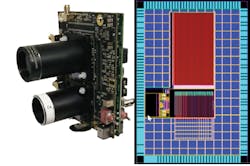Flash lidar and a new way forward—An interview with Claude Florin
In this interview, Carlos Lee talks to Claude Florin, founder and CEO of Fastree3D (Lausanne, Switzerland; see Fig. 1), a company developing vision systems for intelligent automation.
Carlos Lee: What’s the background to you founding Fastree3D?
Claude Florin: While getting my master’s in electronic engineering at EPFL (École Polytechnique Fédérale de Lausanne), I worked on computer vision projects for automotive traffic monitoring and embedded software development for first-generation microprocessors. After graduating in 1981, I joined a joint venture between HP Labs and Philips Healthcare that was focused on advanced 3D multimodality (CT/MR) imaging and compression techniques for digital radiology.
This was a great learning experience, as I was able to learn directly from Hewlett Packard’s founders and its senior executives about the fundamental principles of managing and product innovation in high-tech. In 1997, I moved to HP’s Telecom Software Division and the boom in internet and mobile communications led me to pursue audio and video conferencing, embedded DSP and video coding, and streaming on 3/4G networks in adverse conditions.
After HP, in 2010, I started collaborating with the founders of several startups and moved into early-stage venture capital investment. One project brought me knowledge of laser scanning using MEMS micromirrors, and it was at this time that I met Profs. Edoardo Charbon at EPFL and Robert Staszewski at TU-Delft.
They had developed expertise in precise timing and single-photon detection required for miniature time of flight (ToF) imaging and had co-founded or contributed to various startups in areas such as lidar, microscopy, and quantum cryptography. In 2014, we felt the time was right to set up a company to commercialize 3D imaging technology. And so, together with Lucio Carrara, who had gained expertise at a Swiss photonics proximity sensing company, we founded Fastree3D with the aim of combining a fast detector with readout electronics for 3D imaging.
CL: How has the company developed?
CF: Today, we offer a short-range flash lidar (SRL) with hardware and software components. We’ve demonstrated scene 3D imaging over a 30° field of view at 30 m, and we are developing a system operating at 40,000 pixels at 60 m range with CMOS foundries and VCSEL manufacturers—a use case that avoids beam steering and is the simplest lidar to manufacture.
Modeling a flash lidar involves deep knowledge of semiconductor physics, optoelectronics, and very large-scale integration of semiconductor design. To get here, it took several iterations involving simulations and three generations of prototypes.
CL: What’s different about your lidar technology?
CF: We are pioneering a flash imaging lidar system in which a large area is illuminated repeatedly by a pulsed laser (between 1 and 15 MHz repetition rate). A main advantage of this approach is that it provides ultrafast detection at the quantum limit with picosecond temporal resolution measured simultaneously across all pixels at 30 to 60 fps. Additionally, unlike scanners, the low latency improves short-range collision avoidance and provides homogenous point clouds (see Fig. 2).Other advantages include the fact that resolution can be scaled-up above 50,000 pixels and, because our systems process light at the single-photon, quantum level, they have the unique advantage of enabling quality control in real time, which reduces upstream false detections that are the central issue in scene recognition or interpretation.
Perhaps the main advantage is that our system enables volume manufacturing at low cost because our single-photon avalanche diodes (SPADs) are efficient in near-infrared and compatible with advanced Si-CMOS manufacturing while also interoperating with equally low-cost VCSELs.
CL: How has the industry changed over the last 30 years?
CF: First, the CMOS fabless model has made it possible for our specialized company to compete effectively by designing and producing specific chips without investing in manufacturing. Secondly, there has been a substantial development in cameras over the last 15 years resulting from progress in CMOS image sensor technology. In fact, the lidar system we are building today uses the same CMOS image sensor manufacturing technology used in billions of cameras.
Third, the trends in the automotive industry towards e-mobility, autonomy, digitalization, and electrical drive are having a structural impact on the value-chain. For example, advanced driver-assistance systems (ADAS) rely heavily on embedded software and electronic sensors, mainly cameras and radar, but recently also lidar.
Regarding future trends, some consumer giants have also set their sights on automotive electronic and software components and, for this reason, we see an increased movement towards CMOS image sensors to leverage in high-volume production for consumer electronics, which will be so much bigger. Also, disaggregation of automotive lidar—that is, the separation of post-processing ASICs from front-end lidar—will favor the integration of ASICs with other lasers and detectors. This will result in possible Tier-1 sourcing of standalone system-on-chips for short-range flash lidar, independently from VCSELs or optics. Such trends will require the standardization of volume components to reach sub-$50 full lidar.
Finally, the growth of autonomous robotics and intelligent infrastructure applications will present significant opportunities for low-cost CMOS-SPAD-based lidar, in the same way that the technology became dominant for mobile phone proximity sensors within a few years.
CL: What’s your advice for the next generation of entrepreneurs?
CF: First, keep the stubbornness you had as a young child, when your mother told you not to do something and you went ahead anyway. When we started, advisors told us that lidar systems would not be used in automotive—a view that some industry leaders like Tesla still support. Initially, you will receive rejections from advisors who will tell you that your architecture cannot be realized. Of course, some challenges will need to be resolved. But in the early stage, it’s right to set your eyes on the future and keep your “leap of faith” drive, although you should remain thoughtful and use your education to rationalize your approach.
Secondly, friends and family are more important than finance or a business plan. When you’re in the initial stages, what you need are friends and family that may be convinced by the innovation and help attract other successful people.
Third, you need to be pragmatic in managing your projects. Things take more time and more energy than you plan, so double the time in your plan and talk to people with experience, who will probably advise you to double it another time. But don’t despair because you’re running a marathon, not a sprint.
About the Author
Carlos Lee
Carlos Lee is Director General of the European Photonics Industry Consortium (EPIC; Brussels, Belgium), an active industry association that fosters a dynamic photonics ecosystem by maintaining a strong network and acting as a catalyst and facilitator for technological and commercial advancement.


